 Leading Blog | Posts by Month |
 Leading Blog | Posts by Month |
08.30.24

LeadershipNow 140: August 2024 Compilation
See more on
Posted by Michael McKinney at 07:10 PM

How to Survive, Reset and Thrive with Uncertainty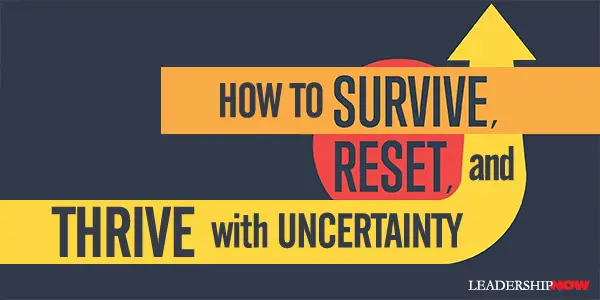
WE can’t predict the pivotal changes still ahead, but we can learn to make good decisions to succeed with them. And not just succeed but grow. Uncertainty is neither good nor bad, depending on what we are trying to do and how we are set up. We can’t make great predictions, but we can learn to make better decisions and look for the possible upsides. We may not be able to plan for uncertainty, but we can prepare for it. To this end, Rebecca Homkes offers Survive, Reset, Thrive as a playbook to help lead successful strategies through an unprecedented range of market conditions. Survive Reset Thrive is a loop. It is an ongoing practice. As you work through the process, you may need to go back to Survive before you Thrive to restabilize. Although it is tempting to think through this linearly, no organization will experience it linearly. It is important to keep in mind that your whole organization will not likely move through it at the same time. Managing all parts of the organization in the same way will not lead to success.
Survive Homkes reminds us that Survive is a part of growth and not the opposite of it. The question becomes, how do you stabilize your organization? A basic survival question to ask is: “Based on current expenses, current linear growth rate, and cash on hand, will the company continue to profitable if the current growth rate does not increase?” If not, you are default dead. More companies are “default dead” than they realize. They are assuming third- or fourth-year bump in growth numbers as the basis for their decisions. But what happens if that assumption is challenged? What happens when a shock triggers a movement into Survive mode? Reset The power of the Survive Reset Thrive loop is in the Reset. And working with this concept is at the core of the book. Reset is the power move. Reset means change. You won’t get to thrive without a powerful reset. How do you update and change your strategy for the changing market conditions? Reset is a revisit of these six key questions that together make up your strategy story:
Thrive In Thrive an organization begins executing an adaptable strategy. Often, the hardest part is to get moving waiting for everything to be in place. Execute with agility. Agility allows you to make good decisions quickly and learn as you go. Homkes talks about learning velocity. If you learn faster, you will grow faster.Getting to Thrive takes what I call disciplined flexibility. This phrase sounds like two contradictory words thrown together, but this is true of most high growth principles. Disciplined flexibility means having a methodical approach that involves testing assumptions, verifying beliefs, and building trackers. And then when you have an insight, you must move quickly! To get to Thrive, you must combine the rigor of developing and testing insights with speed of execution. What sets thriving, high performing organizations apart comes down to five elements that she calls BLAST.

Posted by Michael McKinney at 03:03 PM
08.29.24

Leading Thoughts for August 29, 2024
IDEAS shared have the power to expand perspectives, change thinking, and move lives. Here are two ideas for the curious mind to engage with: Deborah Gruenfeld on power: “Success, impact, and life satisfaction are not the result of how much power you can accumulate, or even how powerful others think you are; they are the result of what you are able to do for others with the power you already have. Source: Acting with Power: Why We Are More Powerful Than We Believe Robert Hurley on stewardship: “Stewardship is about service, not opportunism. The authority to solve complex problems and challenges will reside in the system of stakeholders, not in the leader. The leader’s job is to energize and facilitate, not dominate and control.” Source: The Decision to Trust: How Leaders Create High-Trust Organizations Look for these ideas every Thursday on the Leading Blog. Find more ideas on the LeadingThoughts index.
Posted by Michael McKinney at 11:51 AM
08.27.24

Pattern Breakers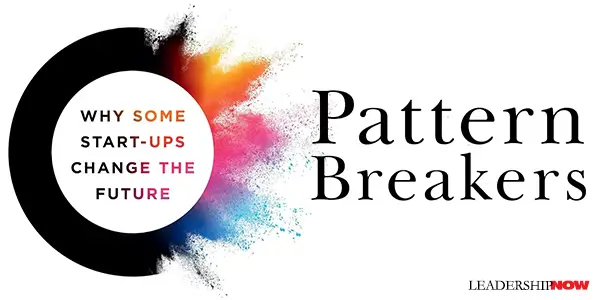
MOST people think that breakthrough ideas come from a vision of the future that is better than what we see today. It is based on the idea that the future will be a new and improved continuation of today. The vision relies on past experiences and then finding patterns that are used to predict the future. However, successful breakthrough ideas require pattern-breaking—unconventional thinking. In Pattern Breakers, authors Mike Maples and Peter Ziebelman explain how pattern breakers live in the future. This is a key idea. Most ideas about the future are an extension of today from people “living in the present, building on the norms of thinking and feeling, and acting that have been previously set by others.” This is what most of us do. In contrast, Pattern Breakers seek to “build for a future that will break from what we know today. They focus on creating a radically different future and commit to discovering inflections and insights that enable them to deliver a pattern-breaking solution.” This is difficult because you’re thinking and working in uncharted territory. And there’s nothing to unlearn. It’s all new. That brings us to two key elements of pattern breakers: inflections and insights. An inflection is an event that creates the potential for radical change in how people think, feel, and act. An insight is a nonobvious truth about how to harness one or more inflections to change human capacities and behaviors in a radical way. Together, these create the conditions for unconventional breakthrough success. Discovering an inflection and developing an insight from it is not easy. The authors offer clues on how to do it. An inflection is “an underlying change that makes an even greater change possible, one that adds to the inventory of what humans do.” For example, “livestreaming, tweeting, web surfing, and ridesharing all harnessed the power of inflections. None of these activities were possible until an inflection conferred new capacities on people.” From a start-up perspective, what makes inflections interesting is that they create an opportunity to alter the rules that govern competition in the future rather than simply improving existing products according to the current rules. Inflections are about exchanging old patterns of behavior for new ones. We tend to create within what we already know—the status quo—and so we never break the pattern to bring about breakthrough success. An insight is how one might use that inflection to change human capacities or behavior. Developing a compelling insight is the main job of the founder. From that, you come up with your idea for a product or service based on the insight. For a breakthrough success, timing is everything. Even if it has been tried before and failed, now may be the time. You may have correctly identified an inflection, but if you act too quickly to harness it, you’ve got a science project. It’s too soon to radically change human behavior. If you act too slowly, you’ve got what is a conventional idea, embraced only after it became obvious to many others—leaving your idea to compete against a crowded field. Pattern breaking is a non-consensus opportunity that forces a choice in the mind of the individual and not a comparison. A pattern-breaking idea isn’t better than the old choice; it is different. Here’s why: When you frame your story around being “better,” you inadvertently accept the existing standard set by established players. This tacitly concedes that the prevailing model defined by the status quo remains relevant. In doing so, you forfeit the opportunity to redefine the game on your terms, without fully realizing what you’ve given up. There are four tests to determine whether or not you have an insight: First, insights must be truths. Second, insights cannot be obvious. Third, insights must harness the power of inflections. And fourth, insights should answer the question, “Why now?” The book is written around start-up ventures, but the concepts are the same when developing an idea within established organizations or anything that needs reinvention. Often, what you see leaders doing is making incremental improvements on what worked before with little success because the playing field has shifted. Essentially, we are improving on what we have done before, which was designed for a world that no longer exists. What is called for is pattern pattern-breaking approach that comes from the future and is not tethered to the past. The enemy is the status quo. Key Reminders for Implementation By spreading too thin over numerous benefits, you risk being forgettable or failing to effectively communicate any one compelling reason for early customers to engage. 
Posted by Michael McKinney at 05:34 PM
08.22.24

Leading Thoughts for August 22, 2024
IDEAS shared have the power to expand perspectives, change thinking, and move lives. Here are two ideas for the curious mind to engage with: Neuropsychologist Paul Pearsall on guilt: “Trying to be guilt-free and have the highest self-esteem leads us into an irresponsible life no matter how successful we are in our careers and social lives. If our ultimate self-help goal is increasing and protecting our self-esteem, we risk preventing ourselves from making necessary substantive changes in our lives.” Source: The Last Self-Help Book You’ll Ever Need Jason Caldwell on mental processing: “Accessing the problem-solving power of your mind is not about pushing; it’s about stopping. Mental processes are at their most effective during times of stillness, but we’ve stopped giving ourselves that opportunity. Because we keep forcing our minds to process, we never give them space to think, and by doing so, we take away their ability to solve.” Source: Navigating the Impossible Look for these ideas every Thursday on the Leading Blog. Find more ideas on the LeadingThoughts index.
Posted by Michael McKinney at 11:22 AM
08.19.24

3 Factors Inventors Share: How to Change the World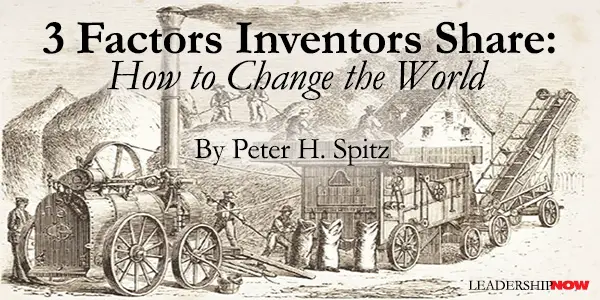
WHAT does it take to make an impact on the world? A great idea, yes, but also three common traits: opportunity, perseverance, and faith. As an inventor with seven patents in the energy and chemical areas I can cite my own experience to substantiate the importance of these traits as factors that lead to success. When I looked back into history to track the origins of some of the everyday innovations we take for granted today, I found that every inventor tended to embody some or all of these same traits. As far back as the Industrial Revolution, inventors have had to focus on more than that brilliant concept — they had to focus on seizing and seeing opportunities, persevering despite the odds, and having faith in their vision and themselves. Consider these four examples: The computer: A thru-line of seeing an opportunity for improvement. In the early 1880s, Charles Babbage, a British mathematician, constructed machines for computing mathematical tables and for conducting calculations using punched cards and a steam engine. Ada Lovelace and two other technicians subsequently wrote programs and built a printing calculator and a punch card tabulating machine. It took a financial entrepreneur, Charles Flint, to merge several of these companies, creating International Business Machines (IBM) in 1924. The radio: A young Italian student perseveres. Guglielmo Marconi was convinced there was a way to send signals through the atmosphere without wires despite being met with rampant skepticism. The technically gifted student conducted several years of promising experiments in Bologna. Finding no local support, he moved his experiments to England and gained the support of Sir. William Pierce, a high-level executive of the British Post Office. The British Marconi Company was founded in 1897. Marconi companies in other countries would dominate wireless transmissions for twenty years. The microwave oven: A company employee keeps the faith. A Raytheon employee named Percy Spencer was shooting down German planes during World War II when his radar gun accidentally melted a candy bar in his pocket. Realizing the device could be used for high-level heating, he and a Raytheon executive cooperated to develop the microwave oven. It took a lot of determination and detours to introduce this blockbuster kitchen appliance in the early 1960s — and it's become a kitchen staple. Post-its: Opportunity plus perseverance equals something we can't do without. Two 3M employees, Spencer Silver and Arthur Fry, discovered that a potential adhesive sticker applied to paper could easily be pulled off. While most 3M researchers had no interest in the development, the inventors stayed the course and had the faith their discovery would be recognized in time. The innovation-friendly culture of the company helped — and eventually, the discovery led to the immensely successful Post-it, first introduced in 1978. The moral of the story: discovery is thrilling, but a good idea is just the beginning. Persisting and tending that discovery by creating a foundation of support is even better. Historically, successful inventions have always been about personal initiative combined with support — a backer, a mentor, a sponsor. Further, the approach taken early in a career can help or hinder in the future, and that goes for any field. So pay special attention to these elements in any project and endeavor you're involved with:
Particularly when you're working in the fields of business, economic development, and innovation, and if you're an aspiring innovator, inventor, entrepreneur, or motivated employee, these three factors will create a solid foundation for later success. But while it's sometimes assumed that the act and business of invention were easier during the Industrial Revolution, think again. In so many cases, new technology exceeded most peoples' imaginations, and inventors had to break new ground in more ways than one. In today's climate, truly anything is possible, and we need all the solutions we can create. It's a good time to innovate.  
Posted by Michael McKinney at 08:59 AM
08.15.24

Leading Thoughts for August 15, 2024
IDEAS shared have the power to expand perspectives, change thinking, and move lives. Here are two ideas for the curious mind to engage with: Brad Stulberg on the inescapability trigger: “A person can tell themselves that what they are doing is not good for them and that they need to stop, but until they mean it in every bone of their body, their mental and emotional energy goes toward finding a solution in the current state instead of imagining a new state altogether.” Source: Master of Change: How to Excel When Everything Is Changing – Including You Morgan Housel on incentives: “No matter how much information and context you have, nothing is more persuasive than what you desperately want or need to be true.” Source: Same as Ever: A Guide to What Never Changes Look for these ideas every Thursday on the Leading Blog. Find more ideas on the LeadingThoughts index.
Posted by Michael McKinney at 10:20 AM
08.09.24

The Way of the Champion
LACROSSE legend Paul Rabil wanted a guidebook for the road to being a champion. So, he went looking for guidance from some of the greatest athletes, coaches, entertainers, and entrepreneurs in the world. He wanted to know what made them great. What he learned he put into this book, The Way of the Champion. Champions aren’t born. They’re made through determination, discipline, and sacrifice. “It’s equal parts strategy, philosophy, psychology—and sheer determination.” Setbacks are expected. They are “opportunities to learn from, to adapt, and to come back stronger. A champion understands that success is upon a foundation of failures, where you choose to rise with unwavering resolve.” The Way of the Champion is divided into three sections: Amateur, Professional and Beyond the Game. In the early stage—amateur—the “goal is to find the thing you will eventually fully commit to. The thing you have potential in.” For the professional, it’s all in. “You have to invest more of your time, more of your resources. To get an edge, you have to do things your competition isn’t willing to do.” Beyond the Game is about impact. “Embrace the responsibility that comes with greatness and use your platform to effect positive change.” Each section is filled with concise essays—short and to the point without the usual fluff. Some lessons from each section: AMATEUR Let Go of Outcomes: “Success and failure come from the same place, so that’s where the archer points all of their attention: not on the outcome, but on the effort. Don’t think about creating a publicly traded company. Think about the problem that needs to be solved, and the value you’re creating for your customers. Let go of the target. The Voice No One Else Hears: How do I speak to myself? We all get into negative thought patterns. “The way to break a negative thought pattern? Be prepared with a positive one.” Be Coachable: “Talent is a commodity. Work ethic is a commodity. But the ability to take coaching and instruction, to hear a critique and then work to address it—that is rare. Be rare. Be coachable. A Week Off Is Really Two: “That the week I took off was two weeks. It was a week of not getting better and it was a week of getting worse. Two weeks less of improving at the things I’m in control of. So, a dividing line between success and failure is simply the ability to bounce back quickly. To accept that failure is part of this process. And never mope just because you messed up, never take a week off. Because it’s really two.” Study the People Who Shouldn’t Be Good: Study the people who shouldn’t be as good as they are. Don’t study the entrepreneur with a wealthy family background and practically unlimited resources who started a successful business. Study the entrepreneur who faced financial struggles, bootstrapped their venture, and encountered numerous failures before ultimately building a thriving company.” Be Great Everywhere: The grunt work is the champion’s work. “What distinguishes the greatest from the merely great is that the greatest don’t turn it on and off. They are wedded to certain behaviors and habits. They do them all the time. They strive for greatness every day, everywhere, on and off the field.” Confidence on Demand: “If you want to build your confidence, go build somebody else’s. If you want to feel good, go make your teammates feel good. Don’t wait for a pat on the back—go pat someone else’s, and it will come right back to yours.” PROFESSIONAL Go Deep: “If you’re struggling in life, I ask you if you have consistency. Turning pro, being consistent, being insane about your craft—requires sacrifice. There’s no more sampling and dabbling.” Confront the Brutal Reality: “Confront the brutal reality—right now. Of your current abilities. Of your injury. Of your team’s prospects. Of your height. Of the odds of making it into the big leagues. Of the situation you got yourself into. Don’t give in to wishful thinking. Don’t lie to yourself. Accept what it is, fully, completely, honestly. Then? Work doing something about it. Prevail in the end, somehow, someway.” The Pendulum Swings: “When you are at an extreme—when things are going well or unwell—remind yourself that the swing in the other direction is just a matter of time. That you can’t have the swing up without the swing down. And you can’t swing back up without experiencing the pain of the downswing. Just commit to the experience and trust that you’ll come around.” Know Who to Listen To: “I had to discern who I listened to—and who to accept feedback from. You have to be able to take the wise criticism and ignore the armchair experts on social media. You have to be able to sift through the noise to figure out what is and isn’t accurate. To know who to listen to.” Make People Better: “The way of the champion is not just a personal quest. It’s not just about your own progress. It’s not just about the heights you alone can reach. The effect you have on those around you is just as important—if not more so. Do you lift others up? Do you bring others along with you? Do you make people better?” BEYOND THE GAME Inspect What You Expect: “In every domain, whether it’s family business, sports, or entertainment, leadership stems from setting clear expectations and demonstrating the dedication and passion needed to surpass them. When leaders inspect what they expect, they cultivate a lasting culture of excellence that endures.” Ask For Help: “When I finally started practicing asking for help, I discovered three things. First, I rarely found anyone who didn’t want to help. People love to help. Second, I found I was building stronger relationships with those whom I showed this type of vulnerability toward. They could trust me. Asking for help is a pillar of honesty. And third, I was able to improve and get things done much faster with help.” We’ll See: “I’ve lost championship and gold medal games, gotten traded multiple times, been through a divorce, made bad investments and worse life decisions. I’ve come out on the other side understanding that there is no ‘good’ or ‘bad.’ Life is complicated. In the moment, at least, you can’t call it. Horrible things lead to incredible things, and vice versa, all the time. Best to accept all that happens. To embrace all that happens. To say to all that happens … We’ll see.” 
Posted by Michael McKinney at 08:08 AM
08.08.24

Leading Thoughts for August 8, 2024
IDEAS shared have the power to expand perspectives, change thinking, and move lives. Here are two ideas for the curious mind to engage with: Simon Bailey on resilience: “Life is full of highs and lows – Life is kind of like a wave in the sense that there are both peaks and dips. Sometimes, you feel like an absolute rockstar. Other times, you feel like the human equivalent of a discarded soft top surfboard. Just remember that you can’t stop the waves but you can learn to surf, which is to say that while the bad times will inevitably come, we have faith that you can always ride them out.” Source: Resilience@Work: How to Coach Yourself Into a Thriving Future Errol Doebler on the importance of emotional awareness: “As you can see, not acknowledging your emotions can be a recipe for disaster. This does not guarantee we’ll always make the right choice. The aim is to make sure you are making a conscious choice. Even when we make the wrong choice based on a conscious decision, we win. You win because you made a decision to go with your instinct, and then you were able to evaluate whether your instinct was good or bad. Source: Ice Cold Leader: Leading from the Inside Out Look for these ideas every Thursday on the Leading Blog. Find more ideas on the LeadingThoughts index.
Posted by Michael McKinney at 02:26 PM
08.05.24

What Leadership Needs to Know about Changing Organizational Culture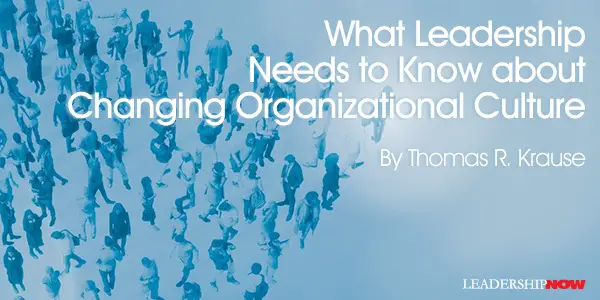
SAY you have a manufacturing location with problems — three plant managers in two years, unusual variation in quality and/or safety, seemingly unpredictable swings in productivity. The options senior leadership considers may be to sell it, give it a defined period to show or go, or take on the task of rehabilitation. Leadership may wonder whether this is essentially a culture problem or whether poor performance itself creates what looks like one. And, if it is the culture that needs to change, what does that really mean? What murky business may be happening underneath that gets recognized as a “culture problem?” And, if the main issue is the culture, what’s the right strategy to change it? Will it take five years? Who has five years? To sort this out, here are important aspects of culture to know: 1. Changing the climate changes the culture. It might take five years to “change the culture,” but that’s irrelevant. Your leaders can change the climate almost immediately. Climate is what leaders are paying attention to and pushing right now. Hold the climate steady for six months, and the culture will start to change. 2. Frequent climate changes negatively affect culture. The problem is that, given leadership turnover, shifting markets and demands, and unexpected changes, the likely pattern is that the climate change will run its course in less than a year and then fade. This isn’t long enough to cause a lasting change in the culture. Then, after this happens a few times, you’ll have influenced the culture, but for the worse, not the better. You’ll have established the expectation that whatever leadership is pushing right now will change fairly quickly, so it doesn’t need to be taken seriously. This is a change in culture, but the opposite of what was needed and intended. 3. Clarify that “organizational culture” isn’t an academic question. Instead, it’s a practical one. The phrase has been kicked around for many years and has taken on different meanings. Some are more useful than others. A common meaning is “how we do things around here.” Another is “what we value.” When you visit a manufacturing location, you start learning about its culture almost immediately — the way you’re treated at the gate, the video you’re told to watch, the looks on the faces of the people you meet, how the first meeting is started, how people conduct and respond in the meeting, how people answer your questions as you tour the facility, what questions they ask you. Within a few hours, you start to have a feel for the place. Would you want your son or daughter to work there? 4. Examine culture via organizational functioning. The most useful way of understanding culture is “how things get done.” Operationally, this means things like communication (especially upward), level of support, trust in leadership, level of teamwork, and perception of justice. 5. Steer away from emphasizing how “leadership creates the culture.” This isn’t because the notion is false but because your leaders don’t understand it. It feels to them like blame, and maybe it is. It sounds like you think leaders are intentionally creating a poor culture, which must be false. A more accurate and useful way of putting it is that leadership decision-making has unintended consequences that show up as cultural issues. 6. Realize the unintended consequences of leadership decision-making. A good way to do this is to analyze decisions related to some seriously negative outcomes. Identify three examples of failed outcomes (related to quality, safety, personnel change, supply chain problem, etc.). Then, trace back and identify the decisions leaders made that led to the failing. Take, for example, a recycling plant catastrophe in which three workers are killed following two explosions. The investigation shows that a used blade scraped the side of the vessel, causing a spark that caused the first explosion, which ignited combustible dust stored nearby and caused the second explosion. Ordered by time, the relevant failed decisions were: 1) A worker replaced a blade in the vessel with a used blade. For many organizations, the “cause” would be identified here, and the investigation would stop. The fix would focus on the employee whose behavior was the issue. Looking further would show that: 2) A decision made by supervision to replace worn blades with used blades was common, happened frequently, and didn’t usually cause problems. Supervision knew this was a common practice. Also, 3) Decisions by management to accept storage of combustible material in proximity of the mixing vessel contributed to the accident. 7. Explore whether analysis suggests a culture issue. Determine whether behavior that leads to sub-optimal operation has become part of the culture. The technical term for this is “normalization of deviance.” If poor upward communication and low support are culprits, both are measurable cultural factors. This pattern was found at NASA after the Columbia Space Shuttle tragedy and is often found in relation to negative outcomes. The central point here is that leadership tended to blame the employee when, in actuality, it was leadership decision-making that created the culture factors that caused the event. Whatever else is going on at a location, knowing how these critical aspects of culture are seen and operationalized will tell you the majority of what you need to know about the culture of the organization. 
Posted by Michael McKinney at 06:29 AM
08.01.24

Leading Thoughts for August 1, 2024
IDEAS shared have the power to expand perspectives, change thinking, and move lives. Here are two ideas for the curious mind to engage with: James Murphy on continuous improvement: “Our philosophy is that if that guy made the mistake, there are 50 other people who made the mistake, or who could. We want to prevent the mistake, not punish the person. He explained that debriefing can completely change the culture of an organization; in fact, he considers debriefing a culture, not an event. “As a leader, it was hard for me to stand up and list the mistakes I made—and what I was going to do about them. You have to accept that to create a culture of accountability, you can always do something better. You have to leave your ego at the door, create a safe environment for everyone, and be sincere. The moment you admit you made a mistake, it empowers everyone in the room.” Robert Hurley on stewardship fundamentals: “Two fairly fundamental principles are associated with the adoption of an integrative stewardship orientation at the top of any organization. One is that the leader understands that the job requires him or her cooperate with and serve all stakeholders instead of competing with them. Stewardship is about service, not opportunism. The others is that the authority to solve complex problems and challenges will reside the system of stakeholders, not in the deader. The leader’s job is to energize and facilitate, not dominate and control.” Source: The Decision to Trust: How Leaders Create High-Trust Organizations Look for these ideas every Thursday on the Leading Blog. Find more ideas on the LeadingThoughts index.
Posted by Michael McKinney at 06:31 PM

First Look: Leadership Books for August 2024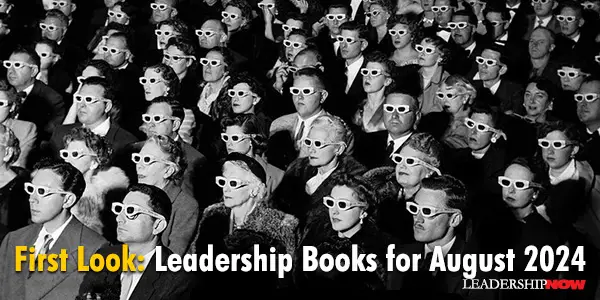
HERE'S A LOOK at some of the best leadership books to be released in August 2024 curated just for you. Be sure to check out the other great titles being offered this month.
An engaging guide to owning and elevating your work experience. With tips, watchouts, and funny stories, Leading Yourself will give you the encouragement and tactics to up-level your career, even if you aren't in your dream job. You'll learn to manage your self-talk, find meaning in the mundane, optimize your time at work, and build relationships with the people who matter.
In an era marked by increasing profiteering and inequality, The Ethical Imperative offers a compelling alternative vision―one where companies champion the collective prosperity of employees, shareholders, and communities. Cooper leverages academic studies and research to challenge the status quo. He exposes the critical threat of public disengagement from businesses and institutions, urging a departure from outdated, profit-only models that harm corporations, consumers, and communities alike.
Companies are fighting the wrong battle. The consensus has been to learn the best practices from tech giants and then imitate them. But new paths for growth aren't created by imitation; they're forged by radical differentiation. In Smart Rivals, Harvard Business School professor Feng Zhu and former Bloomberg journalist Bonnie Yining Cao show business leaders how to create competitive advantages by offering product features and benefits that tech giants and other competitors cannot match in the digital/AI age.
Technology, isolation, and increasing demands for productivity are making the workplace a hotbed for stress—it's no surprise employees are abandoning traumatic workplaces in unprecedented numbers. Ed Beltran, the CEO of a powerhouse leadership communication company, believes the antidote to stressed-out workplaces starts with conversation. This is no ordinary self-help book. The transformative process of fierce resilience goes well beyond developing mere coping skills. It helps people take control of their emotional health, become more resilient, and build organizations with resilience as a core part of their DNA.
How you do anything is how you do everything. Great performance, whether at work or at home, starts with the little things: making your bed, organizing your closet, maintaining your yard, shooting a basketball, closing a deal. Elevate Your Excellence offers a foolproof approach to improve the often-neglected everyday disciplines like hydration, sleep quality, and mindset maintenance that can make all the difference in generating high-quality performance. Anderson encourages readers to make simple and immediately actionable tweaks to begin doing ordinary things extraordinarily well to transform their lives.
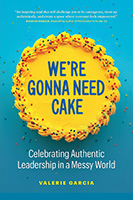 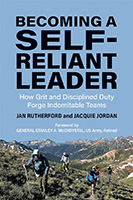 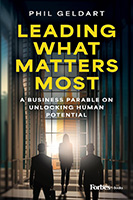 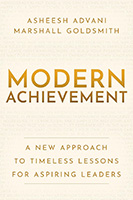
“Miss a meal if you have to, but don't miss a book.” — Jim Rohn
Posted by Michael McKinney at 08:55 AM
|
BUILD YOUR KNOWLEDGE


How to Do Your Start-Up Right STRAIGHT TALK FOR START-UPS 
Grow Your Leadership Skills NEW AND UPCOMING LEADERSHIP BOOKS 
Leadership Minute BITE-SIZE CONCEPTS YOU CAN CHEW ON 
Classic Leadership Books BOOKS TO READ BEFORE YOU LEAD |
|